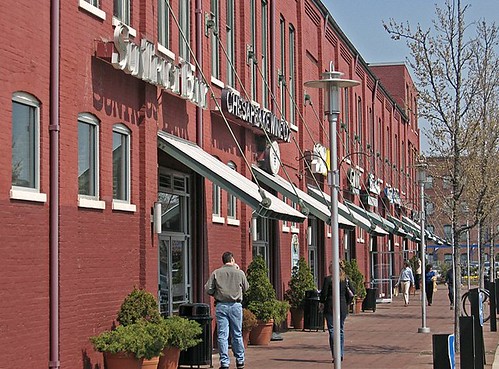Will downtown comebacks, entrepreneurs reverse commercial sprawl?

Posted November 30, 2011 at 1:29PM
I was impressed by an editorial a few days ago in the Raleigh News & Observer, suggesting that North Carolina’s capital city might do well to encourage entrepreneurs to locate start-up businesses in downtown Raleigh. The editorial takes the position that, just as Richard Florida has been telling us for a decade, creative types feed on the kind of proximity to each other that only a critical mass of nearby, like-minded types can provide:
“One entrepreneur noted that there are lots of people in Raleigh doing interesting things, ‘but they're miles apart from each other.’ Further, said Josh Whiton, a 31-year-old chief executive of a software company downtown, ‘There's not the serendipitous running into each other when you go to the coffee shop.’
“Whiton notes that [nearby] Durham has been able to create that kind of concentration. Hmmm ... does anyone else see a similarity in Raleigh's scattered, sprawling growth pattern of years past for residential neighborhoods and the way businesses are far-flung?"
Writing in The New York Times, Louise A. Mozingo of UC-Berkeley says that the “pastoral capitalism” of suburban office parks and campuses has become an outmoded model. Among the consequences, she cites the isolation of these office enclaves:
“Suburban offices are even more unsustainably designed than residential suburbs. Sidewalks extend only between office buildings and parking lots, expanses of open space remain private, and the spreading of offices over large zones precludes effective mass transit.
“These workplaces embody a new form of segregation, where civic space connecting work to the shops, housing, recreation and transportation that cities used to provide is entirely absent. Corporations have cut themselves off from participation in a larger public realm.”
To meet the needs of a “post-peak-oil future,” Mozingo urges that we shift from funding sprawl-inducing highway expansion to repair and maintenance of existing infrastructure; retrofit existing office sprawl with better transit, civic space, and pedestrian connections to nearby residential areas; and encourage future office location in downtowns and civic centers.
Retail sprawl also is on the decline. My friend Chris Leinberger observes in The New York Times:
“Drive through any number of outer-ring suburbs in America, and you’ll see boarded-up and vacant strip malls, surrounded by vast seas of empty parking spaces. These forlorn monuments to the real estate crash are not going to come back to life, even when the economy recovers.”
Even in regions where the local economy is relatively strong, constituencies are beginning to make additional demands on sprawl-based retailers. Yesterday’s Washington Post, for example, contained two articles on challenges facing Walmart and other big-box outlets seeking to expand in the DC area.
In one, Victor Zapana notes that a bill has been introduced before the Montgomery County (MD) Council by the Council president that would require all large, big-box stores to meet with community groups and negotiate legally binding community benefits agreements on subjects such as wages, benefits and environmental issues. The bill is controversial and faces an uncertain future but, in another article, Nikita Stewart and Jonathan O’Connell write that a Safeway supermarket in southeast Washington, DC may seek to block Walmart’s entry into that area.
In addition to the issues facing commercial properties, we have known for some time that the market for new suburban residential housing is undergoing significant change. In particular, the boom days for new, large-lot housing on the fringe appear to be over. Chris Leinberger continues:
“In the late 1990s, high-end outer suburbs contained most of the expensive housing in the United States, as measured by price per square foot, according to data I analyzed from the Zillow real estate database. Today, the most expensive housing is in the high-density, pedestrian-friendly neighborhoods of the center city and inner suburbs . . .
“Simply put, there has been a profound structural shift — a reversal of what took place in the 1950s, when drivable suburbs boomed and flourished as center cities emptied and withered.”
Leinberger, who explored this same territory several years ago in The Atlantic, finds the reasons in demographic trends:
“The shift is durable and lasting because of a major demographic event: the convergence of the two largest generations in American history, the baby boomers (born between 1946 and 1964) and the millennials (born between 1979 and 1996), which today represent half of the total population.
“Many boomers are now empty nesters and approaching retirement. Generally this means that they will downsize their housing in the near future. Boomers want to live in a walkable urban downtown, a suburban town center or a small town, according to a recent survey by the National Association of Realtors.
“The millennials are just now beginning to emerge from the nest — at least those who can afford to live on their own. This coming-of-age cohort also favors urban downtowns and suburban town centers — for lifestyle reasons and the convenience of not having to own cars.
“Overall, only 12 percent of future homebuyers want the drivable suburban-fringe houses that are in such oversupply.”
Given the decline in demand for sprawl housing, it is inevitable that demand for commercial sprawl will decline as well. I think there is little question that for an abundance of reasons future development in America – both commercial and residential – is going to be more urban, more walkable, and less sprawling. The communities that prosper most as the 21st century matures will be the ones that recognize these shifts and welcome them with the right kind of planning, development, and amenities.
Thanks to Merry Rabb for pointing me to the Raleigh editorial.
Move your cursor over the images for credit information.

